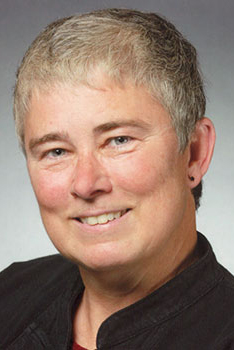Professor of Biomedical Science
Education
Postdoctoral Research Associate Department of Pharmacology Northwestern University 1986.
Postdoctoral Research Associate Department of Internal Medicine University of Iowa 1983.
Burroughs-Wellcome Postdoctoral Fellow Department of Internal Medicine University of Iowa 1982.
Ph D Pharmacology and Toxicology University of Iowa 1981.
MS Pharmacology and Microbiology Idaho State University 1976.
BS Microbiology Idaho State University 1973.
Interests & Expertise
Janis Eells’s research focuses on the ways to treat Retinal Degeneration and Disease.
The Role of Mitochondrial Dysfunction in Retinal Degeneration and Disease
Mitochondria play a key role in cellular energy metabolism and intracellular signaling processes. These organelles are involved in many complex signaling cascades regulating both cell survival and cell death. Importantly, mitochondrial dysfunction and the resulting oxidative stress are central in the pathogenesis of aging and degenerative diseases including diabetes, cardiovascular disease, macular degeneration and Alzheimer’s disease.
Research in her laboratory is directed at understanding the mitochondrial signaling pathways that regulate the processes of cellular aging and degeneration with the long-term goal of learning how to protect cells and tissues against these degenerative processes.
Photobiomodulation in Retinal Degeneration and Disease
Evidence is growing that exposure of cells to low-energy photon irradiation in the near-infrared (NIR) range of the spectrum, collectively termed photobiomodulation (PBM), can restore the function of damaged mitochondria, upregulate the production of cytoprotective factors and prevent apoptotic cell death.
Photobiomodulation has been applied clinically in the treatment of soft tissue injuries and acceleration of wound healing for more than 40 years. Photobiomodulation studies in Eells’ laboratory have demonstrated improved clinical outcomes, increased production of cytoprotective factors and improved cell survival in animal models of Parkinson’s disease, diabetes mellitus and retinal degeneration.
Investigations into the mechanisms of photobiomodulation have shown that NIR photons are absorbed by the mitochondrial photoacceptor molecule, cytochrome c oxidase triggering intracellular signaling pathways that culminate in improved mitochondrial energy metabolism, increased cytoprotective factor production and cell survival. Research in her laboratory employs electrophysiological, neuroimaging, histochemical and molecular methodologies.
Selected Publications
Gopalakrishnan, S., Mehrvar, S., Maleki, S., Schmitt, H., Summerfelt, P., Dubis, A. M., Abroe, B., Connor, T. B., Carroll, J., Huddleston, W. E., Ranji, M., & Eells, J. T. (2020, December).
Photobiomodulation preserves mitochondrial redox state and is retinoprotective in a rodent model of retinitis pigmentosa. Scientific Reports,
10(1).
Pinilla, I., Fernández-Sánchez, L., Segura, F. J., Sánchez-Cano, A. I., Tamarit, J. M., Fuentes-Broto, L., Eells, J. T., Lax, P., & Cuenca, N. (2016, September).
Long time remodeling during retinal degeneration evaluated by optical coherence tomography, immunocytochemistry and fundus autofluorescence. Experimental Eye Research,
150, 122-134.
Gonzalez-Garcia, S., Hernandez-Diaz, Z., Quevedo-Sotolongo, L., Pena-Sanchez, M., Pino-Pina, Y., Fernandez-Carriera, R., Menendez-Sainz, C., Gonzalez-Quevedo, A., & Eells, J. T. (2014). Resistive cerebral blood flow as a potential marker of subclinical brain damage in essential hypertension. World Journal of Cardiovascular Diseases, 4, 169-178.
Coleman, K., Johnstone, D. M., Torres, N., Eells, J. T., Baker, G. E., Ashkan, K., Stone, J., Benabid, A., & Mitrofanis, J. (2014).
The potential of light therapy in Parkinson’s disease. Chronophysiology and Therapy,
4, 1-14.
Pena-Sanchez, M., Gonzalez-Garcia, S., Riveron-Forment, G., Fernandex-Concepcion, O., Martinez-Bonne, O., Lemus-Molina, G., Fernandez-Almirall, I., Menendez-Sainz, M., Gonzalez-Quevedo, A., & Eells, J. T. (2014). Association of serum antioxidant enzymes and nervous tissue markers in hypertensive patients. World Journal of Cardiovascular Diseases, 4, 160-168.
Maleki, S., Gopalakrishnan, S., Ghanian, Z., Spehr, R., Schmitt, H., Eells, J. T., & Ranji, M. (2013).
Optical imaging of mitochondrial redox state in a rodent model of retinitis pigmentosa. J. Biomed. Optics,
18(1), 1-8.
Muili, K. A., Gopalakrishnan, S., Meyer, S. L., Eells, J. T., & Lyons, J. (2013).
Photobiomodulation induced by 670nm light ameliorates MOG35-55 induced EAE in female C57BL/6 mice: A role for remediation of nitrosative stress. PLoS One,
8(6), e67358.
Tang, J., Du, U., Lee, C. A., Talahalli, R., Eells, J. T., & Kern, T. S. (2013).
Low-intensity far-red light inhibits early lesions that contribute to diabetic retinopathy: in vivo and in vitro. Invest. Ophthalmol. Vis. Sci,
54(5), 3681-3690.
Muili, K. A., Gopalakrishnan, S., Meyer, S. L., Eells, J. T., & Lyons, J. (2012).
Amelioration of experimental autoimmune encephalomyelitis in C57BL/6 mice by photobiomodulation induced by 670 nm light. PLoS One,
7, 30655.
Wasson, C. J., Zourelias, J. L., Aardsma, N. A., Eells, J. T., Ganger, M. T., Schober, J. M., & Skwor, T. A. (2012).
Inhibitory effects of 405 nm irradiation on Chlamydia trachomatis growth and characterization of the ensuing inflammatory response in HeLa cells. BMC Microbiology,
12, 176-186.
Eells, J. T., Quirk, B., DeSmete, K., Henry, M., Buchmann, E., Wong-Riley, M., & Whelan, H. (2012).
Therapeutic effect of near Infrared (NIR) light on Parkinson’s disease models. Frontiers in Bioscience,
4, 818-823.
Honors & Awards
Research Foundation Senior Faculty Award (2016) University of Wisconsin-Milwaukee.
Dean’s Research Award (2015) College of Health Sciences, University of Wisconsin-Milwaukee.
Wisconsin Distinguished Professorship (2004) Wisconsin Distinguished Professorship Program.
Chairperson of Task Force responsible for the formation of the Environmental Health Criteria for Methanol (1997) World Health Organization.
Invited Participant-Methanol Work Group (1992) Health Effects Institute: Mobile Air Toxics Workshop.
Postdoctoral Fellowship (1984) National Institutes of Health.
Postdoctoral Fellowship (1981) Burroughs-Wellcome.
Pre-doctoral Fellowship (1977) National Institutes of Health.
Graduate Fellowship (1975) American Foundation for Pharmaceutical Education.
Undergraduate Research Fellowship (1973) National Science Foundation.
